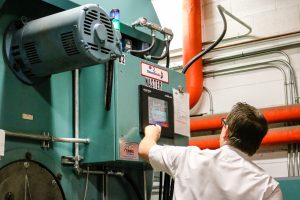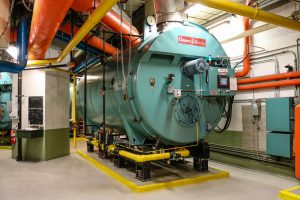
Tips on major boiler retrofit options
August 28, 2019 | By Rakesh Zala

Instead of replacing the two nearly 30-year old boilers at First Canadian Centre in Calgary, GWL Realty Advisors chose to replace the burners with high-efficiency ones and upgrade the controls to a PLC-based system with oxygen trim and parallel positioning. Photo Tundra Process Solutions

As a result of the boiler retrofit, First Canadian Centre decreased its emissions from uncontrolled (130 ppm NOx) to low NOx (30 ppm) and reduced its fuel usage by 20 per cent. Photo Tundra Process Solutions
One-third of a facility’s energy bill stems from the boiler room, and system inefficiency just adds to high energy costs. If replacing a boiler is not an option due to budget constraints, retrofitting an old boiler is one way to bring it nearly up to par with today’s new systems.
THE CAUSE OF INEFFICIENCY
The main cause of energy inefficiency is system heat loss. The average level of efficiency for industrial boilers is only 75 per cent to 77 per cent. The first place to look for improvements is in the control system. The following control developments produce measurable efficiency increases and fuel-cost reductions and they are available for retrofitting into an existing system.
- Parallel Positioning – Many boiler burners are controlled by a single modulating motor with jackshafts to the fuel valve and air damper. This arrangement, set during startup, fixes the air-to-fuel ratio over the firing range. Unfortunately, environmental changes such as temperature, pressure and relative humidity alter the fixed air-to-fuel ratio, making combustion inefficient. To account for these conditions, boilers with jackshaft systems are typically set up with a high amount of excess air. This higher excess air level reduces boiler efficiency and, over time, linkages wear – making repeatability impossible.
To solve this problem, consider incorporating parallel positioning into the control system. It is a process using dedicated actuators for the fuel and air valves. Burners that incorporate parallel positioning can be set with lower excess air levels. Energy savings of up to five per cent may be realized.
- O2 trim – An oxygen sensor/transmitter in the exhaust gas continuously senses oxygen content and provides a signal to the controller that “trims” the air damper and/or fuel valve, maintaining a consistent oxygen concentration. This minimizes excess air while optimizing the air-to-fuel ratio.
- Variable speed drive – Variable speed drives enable a motor to operate only at the speed needed at a given moment, rather than a constant 3600 RPM as a drive runs. This speed variance results in the elimination of unnecessary electrical energy consumption. A variable speed drive can be used on any motor but is most common on pumps and combustion air motors of greater than 5 HP. These drives also produce quieter operation compared to a standard motor and they reduce maintenance costs by decreasing the stress on the impeller and bearings.
- Lead lag – Lead lag sequences the operation of multiple boilers, matching system load. Lead lag enables the boilers to operate at peak efficiency, reduces cycling and decreases maintenance and downtime.
TAKE BACK THE HEAT
Another way to please budget scrutinizers while improving energy efficiency is by incorporating heat recovery retrofits into the boiler system.
- Economizers – Economizers transfer energy from the boiler exhaust gas to the boiler feed water in the form of “sensible heat.” Sensible heat is created by the transfer of the heat energy of one body, in this case exhaust gas, to another, cooler body – the boiler feed water. This reduces the boiler exhaust temperature while preheating the boiler feed water, increasing overall efficiency. Economizers typically increase energy savings by 2.5 per cent to 4 per cent.
- Two-stage condensing economizers – This type of economizer combines the functions of both a standard non-condensing economizer and a condensing economizer. The first section of the economizer recovers energy by preheating boiler feed water. The second section recovers energy by preheating a cool liquid stream such as make-up water. Sensible and latent energy is captured from the flue gases that leave the boiler. Condensing economizers can increase energy savings by up to 10 per cent, depending on design and operating conditions.
- High turndown burner – Increasing burner turndown rate reduces on-off cycles.
Each on-off cycle is followed by purge cycles. During a purge cycle, large volumes of room air pass through boiler, resulting in heat being blown out the stack.
- Blowdown heat recovery – All boilers must remove dissolved solids from the boiler to maintain water purity and ensure a long boiler life. Many boiler rooms route blowdown to a flash tank that allows safe discharge of the steam by reducing (flashing) the steam pressure in an enclosed tank. Low-pressure steam is vented from the tank and condensate is discharged to the drain. In many cases, these tanks are not insulated nor do they allow recovery of the lost heat. A blowdown heat recovery system transfers the blowdown steam energy to the boiler feed water, recuperating about 90 per cent of this energy.
Rakesh Zala is vice president, product engineering-packaged boiler systems for Cleaver-Brooks.





